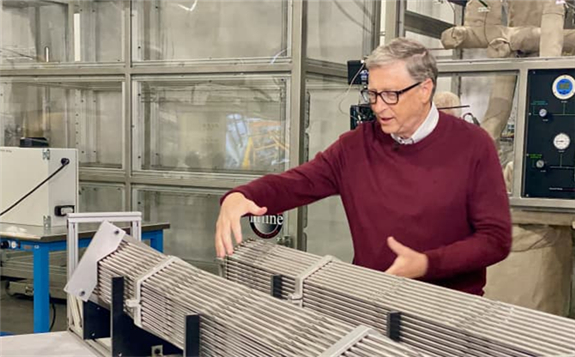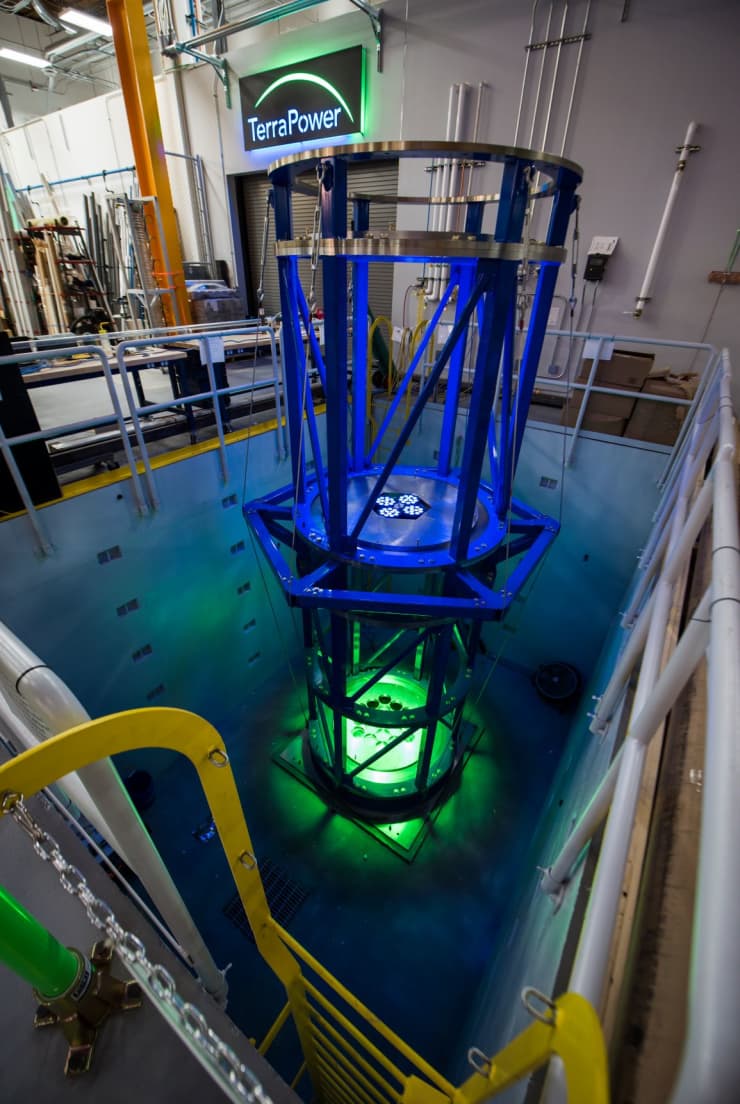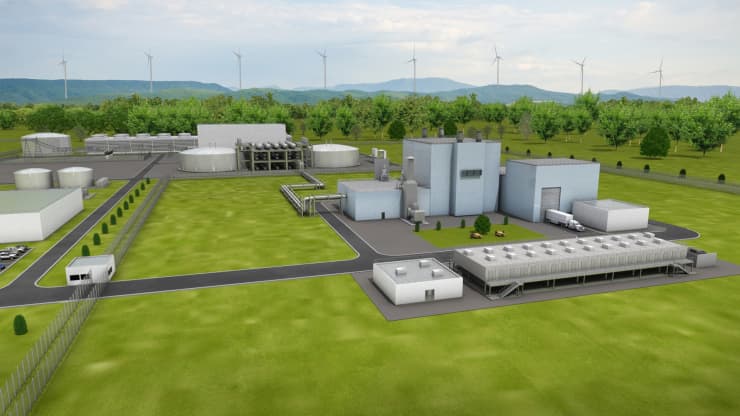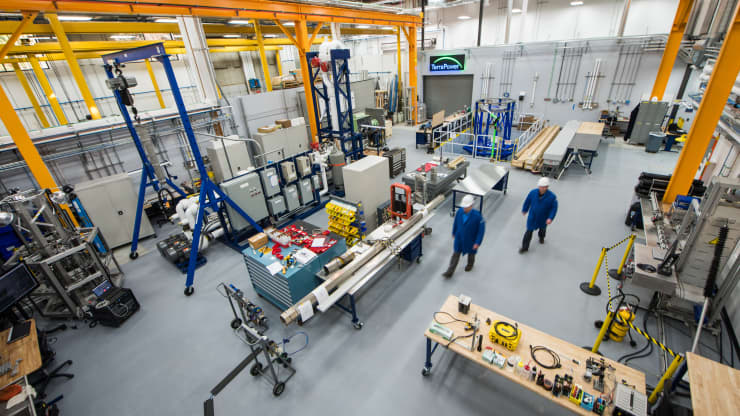When Bill Gates started learning about nuclear power innovation, “I was skeptical, but also intrigued,” he wrote on his Gates Notes blog in 2019.
 Bill Gates at TerraPower with with a mock-up of metal fuel pin bundles.Photo courtesy Gates Notes
Bill Gates at TerraPower with with a mock-up of metal fuel pin bundles.Photo courtesy Gates Notes
Like many people, Gates’ opinion of nuclear power had been tinged by past disastrous accidents such as Three Mile Island and Chernobyl.
But Gates was also interested in the potential of nuclear power as a clean energy.
After reading a paper about a new generation of nuclear reactors built with technical advancements to guard against such accidents, Gates founded TerraPower in 2008 to realize the benefits of these innovations.
Selected by the U.S. federal government to demonstrate the viability of nuclear power through its Advanced Reactor Demonstration Program (ARDP), TerraPower aims to build “fully functional advanced nuclear reactor within 7 years of the award,” according to the Office of Nuclear Energy at the U.S. Department of Energy.
“We envision a 2050 grid that is powered by very significant wind and solar power, but is complemented by” Terra Power nuclear reactors, TerraPower president and CEO, Chris Levesque, tells CNBC Make It.
Levesque envisions that TerraPower will help the United States become a dominant force in nuclear power; as other countries transition their energy grids, “the United States will once again export reactors that set the standard for the world, just as we did for today’s conventional reactors,” Levesque says.
TerraPower’s ability to achieve those goals will be in no small part due to the money and influence of the company’s founder.
“The most important factor is that Bill Gates is behind this,” principal research scientist at the Massachusetts Institute of Technology department of nuclear science and engineering Charles Forsberg tells CNBC Make It. “The most important factors in developing a new reactor are money and very competent people. Bill Gates brings both to the project.”
Here’s how TerraPower is building advanced nuclear power plants.
A safer cooling system
Despite nuclear power’s baneful reputation, it is actually the safest form of power generation when analyzed by deaths per unit of electricity generated, according to Gates.
And TerraPower’s Natrium Reactor plants will be safer still, thanks in large part to a more reliable cooling system for its reactors.
Nuclear fission, a process where atoms split and release a large amount of energy, generates a lot of heat. In conventional nuclear power plants, called light-water nuclear reactors, water absorbs that heat, turning it to steam. The steam then turns a turbine to produce electricity.
The problem is, that steam can also build up and create pressure inside of a reactor, which has the potential to cause an explosion.
So TerraPower’s Natrium plant uses a different method, pioneered decades ago: liquid sodium as a cooling agent. (“Natrium” means “sodium” in Latin.) Liquid sodium has a higher boiling point and can absorb a lot more heat than water, which means high pressure does not build up inside the reactor.
“Liquid sodium has certain improved thermochemical properties when compared to water that can change risk profiles and reduce the probability of events that might be more probable in a light water reactor,” says Brett Rampal, the director of nuclear innovation at non-profit Clean Air Task Force.
 TerraPower’s test facility is where the company does full-scale physical testing for fuel handling operations.Photo courtesy TerraPower
TerraPower’s test facility is where the company does full-scale physical testing for fuel handling operations.Photo courtesy TerraPower
Beyond that, TerraPower’s cooling system does not rely on any outside energy source to operate in the event of an emergency shutdown of a reactor. Instead, its system works via the hot air rising from natural circulation within the system, called a reactor vessel air cooling system, or RVACS, says Levesque.
This can prevent accidents like what happened at the Fukushima Daiichi plant in Japan. After an earthquake shut down the plant’s reactor, its back-up cooling system failed. “They relied on pumps that had to be powered by diesel generators. When [a subsequent] tsunami disabled the diesels, they lost all cooling to the reactor, which led to melting and the further problems,” Levesque says.
Such “passive” cooling systems, which rely on things like natural circulation or gravity, “are at the heart of advanced reactor designs and reduce the risk and severity of accidents,” Rampal says. And they’re trustworthy, Forsberg says: “This type of passive safety system has been demonstrated on a large scale.”
Energy storage, like a battery
Natrium technology has the ability to store heat in tanks of molten salt for future use, “much like a battery,” Levesque says. (The technology is similar to that used in solar plants, which use the technique to store power for when the sun is not shining.)
That storage capability can increase a Natrium Reactor plant’s power output from about 345 megawatts to 500 megawatts for five hours, Levesque says.
 An artist rendering of a TerraPower Natrium power plant.Photo courtesy TerraPower
An artist rendering of a TerraPower Natrium power plant.Photo courtesy TerraPower
“It is the first nuclear concept to integrate large-scale energy storage capabilities,” Levesque says. “This solves a real challenge utilities face as they plan for the long term and work to achieve decarbonization goals.”
While TerraPower is a leader here, according to Rampal, other advanced nuclear companies are also considering storage.
“Most of the advanced reactor developers I have interacted with in the past five years include thermal storage in a conceptual plant layout,” says Andrew Whittaker, an engineering professor at the University at Buffalo who researches nuclear structures. “It makes good financial sense.”
Cheaper construction costs
In America, the cost of building a conventional nuclear power plant can be in the multibillions. (For instance, two units being built at Plant Vogtle in Georgia are expected to cost more than $25 billion, according to analyst estimates cited by Reuters.)
The target cost for a commercial Natrium plant is $1 billion in capital expenditures, according to TerraPower. That includes engineering, procurement and construction costs of the plant.
The lower cost estimate is partly due to Natrium plants operating at lower pressure (because of the liquid sodium); they do not require the same heavy duty, expensive construction materials, according to Levesque.
TerraPower plants are also smaller than conventional ones, which is “important for lowering the capital cost” Levesque says.
The size also makes TerraPower plants attractive to utility companies “looking to invest in a nuclear power plant to plug into their existing power grid,” says Levesque. TerraPower’s plants have the capacity to generate enough power to operate a small city, which is the “sweet spot” for utility companies.
“A very large plant is a big risk for a utility,” Levesque says.
Less nuclear waste
Radioactive waste, a byproduct of nuclear fission, “produce fatal radiation doses during short periods of direct exposure,” according to the U.S. Nuclear Regulatory Commission. With no permanent storage solution in use in the U.S., nuclear waste is currently stored at the facility where it was generated in concrete and steel containers.
Advanced nuclear reactors however, produces less waste. That includes Natrium technology, which utilizes radioactive uranium fuel (which powers nuclear reactors) much more efficiently and more completely than conventional plants, according to Levesque.
 Inside TerraPower’s lab.Photo courtesy TerraPower.
Inside TerraPower’s lab.Photo courtesy TerraPower.
“This is enabled by a very precise reactor design process that took advantage of today’s high performance computing and advanced materials. Thus the used fuel, also called ‘spent’ fuel, occupies 2/3 less volume than today’s reactors, per gigawatt-hour of power generated,” he says.
Experts are mixed on whether this innovation is useful however. While Whitaker calls it a “significant gain in efficiency” that is “important,” Forsberg says it’s “not relevant,” because it “does not really impact disposal costs.”
Still, some say nuclear power is the wrong solution
Despite what Gates and TerraPower see as benefits, the debate over nuclear power is fierce.
On March 18, for instance, the Union of Concerned Scientists (UCS), a non-profit group of 250 scientists and related professionals, issued a 140-page rebuke of “advanced nuclear” reactor designs.
“If nuclear power is to play a larger role to address climate change, it is essential for new reactor designs to be safer, more secure, and pose comparable or—better yet—lower risks of nuclear proliferation and nuclear terrorism than the existing reactor fleet,” says Edwin Lyman, Director of Nuclear Power Safety at the Union of Concerned Scientists in Washington, DC, in a statement released with the report. “Despite the hype surrounding them, none of the non-light-water reactors on the drawing board that we reviewed meet all of those requirements.”
The UCS even recommends the Department of Energy (DOE) suspend its jointly funded ARDP demonstration project (in which TerraPower is a particpant) until regulatory agencies determine what kind of prototyping is necessary, and calls on the DOE to have an independent commission to review the project.
“It doesn’t make sense to us for either government or industry to devote a lot of resources to pursuing high-risk, low-reward technologies – or technologies that could be even worse than what we have now,” Lyman tells CNBC Make It.
Instead, more federal government spending to improve conventional reactors is a better tactic, according to the UCS.
“Investment to address the shortcomings of conventional reactors would have a higher chance of success because there is a large base of operating experience and experimental data that researchers can draw upon,” Lyman says.
In response to the UCS report, Levesque re-emphasizes the utility of the safety measures TerraPower’s Natrium plant employs. And Levesque, who says he’s spent most of his career working with conventional water-cooled reactors, does not object to reinvesting in their maintenance.
“But the fact is, light water reactors are based on 50-plus-year-old technology, and only incremental improvements can now be made. Moving on to advanced reactors like Natrium allows transformational improvements in economics and safety,” he says.
Still others say focusing on nuclear power at all is the wrong approach.
Nuclear power, which has been around since the 1950s, “has proven to be very slow to deploy, very expensive, and fraught with dangers,” says Robert W. Howarth, professor of ecology and environmental biology at Cornell University. “And no one has ever solved the problem with what to do with nuclear wastes.”
Safe and affordable nuclear power is “a pipe dream” that “never materialized,” he says.
Michael E. Mann, professor of atmospheric science at Penn State and director of the Penn State Earth System Science Center (ESSC), argues that nuclear energy “comes with unnecessary risks when better alternatives (i.e. wind, solar, geothermal) are available.”
And “investment in nuclear likely crowds out investment in the safer alternative (renewable energy),” he says.
Both Howarth and Mann are signatories on a declaration that calls for decarbonization through 100% renewable energy, like wind and solar.
“A decade ago, perhaps one could still argue we need new nuclear power plants to combat global warming, and that better approaches were hopefully just around the corner,” Howarth says. “But in 2021, it is very clear that we can completely rebuild the energy economy of the world moving forward built on renewable energy alone, with no need for fossil fuels or nukes. To build our future on renewables is that fastest, safest, and cheapest way to address climate disruption.”